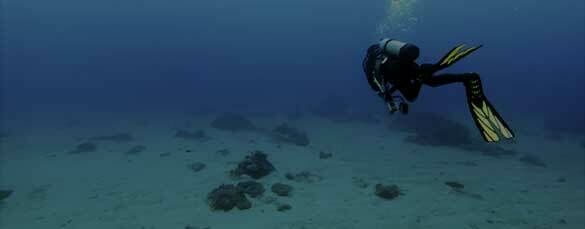Pneumothorax
An individual who suffers pulmonary barotrauma whilst diving is at risk of developing a pneumothorax (which will often become a tension pneumothorax on ascent as ambient pressure is reduced) and/or surgical emphysema and/or arterial gas embolism. It is therefore recommended that individuals who are believed to be at significantly increased risk of pulmonary barotrauma compared with the general population should not dive.
Lung disease which might be expected to cause gas trapping during ascent is particularly likely to predispose to pulmonary barotrauma. However, there is little objective evidence to date that obstructive lung disease per se increase the risk of pulmonary barotrauma in divers. There is some evidence to suggest that pulmonary barotrauma does occur more frequently in divers whose lungs are small and stiff.
Special consideration needs to be given to individuals who have previously suffered pneumothorax or pulmonary barotrauma. Three situations must be considered:
1. Spontaneous pneumothorax.
A spontaneous pneumothorax is one which occurs without precipitating trauma. It may occur in (generally older) individuals with severe underlying lung disease (e.g. chronic airways disease) when it is clear that the nature of the lung disease would prevent diving. They are numerically equal to the numbers that occur in young persons (see below) but are more serious due to the lack of pulmonary reserve.
It may also occur in fit and healthy young adults who might otherwise be good candidates for diving. They are more frequent in young men than young women (7:1) and they are more common in smokers than non-smokers. In young men, “light” smoking increases the risk seven fold, moderate smoking raises the risk to 20-fold and heavy smoking raises it to 100-fold.
Some spontaneous pneumothoraces are associated with forced inspiratory manoeuvres such as hiccuping or the completion of functional tests of total lung capacity or peak inspiratory pressures. Such cases suggest that voluntary high inflations can stretch some parts of healthy lungs beyond their elastic limits. 60% of the spontaneous pneumothoraces are noted in the first 3 hours of the waking day. Almost all are unilateral and affect the right and left lungs with equal frequency, but some 2% are bilateral, probably betraying a defect in the mesothelial barrier separating the two pleural spaces in the antero-superior mediastinum. They rarely occur after the age of 40 years.
Recurrence rates after recovery from a first spontaneous pneumothorax are high (≈50%), are more commonly ipsilateral than contralateral but are very infrequent after intervals of two years or more. The medical committee has therefore adopted the pragmatic approach of accepting that in individuals with a history of spontaneous pneumothorax who have had a bilateral pleurectomy or who are unoperated upon but had no pneumothorax for five years the risk of pulmonary barotrauma is small and not significantly greater than for many in the general population e.g. smokers. Such individuals may dive provided that a CT scan of the chest and lung function tests show no reason to suggest that there is significant residual lung disease.
2. Traumatic pneumothorax.
Traumatic pneumothorax may follow blunt or penetrating trauma, including iatrogenic. This will include pneumothorax occurring as a result of positive-pressure ventilation (over-pressure pulmonary barotrauma). In all these situations there are good reasons for the individuals to have sustained their pneumothorax and there is no reason to suppose that such individuals will be at increased risk of pulmonary barotrauma when diving, provided that there has been complete resolution of associated lung pathology.
Resolution should be assessed by evidence of healing or resolution of the pneumothorax or that the chest has returned to normal as evidenced by an appropriate letter from the treating physician which is likely to already be in the notes and lung function tests. If a report or copy of a relevant letter from the treating physician cannot be obtained then a chest X ray could be considered. However, complex traumatic injury that could potentially result in air trapping could possibly need more detailed investigation.
3. Pulmonary barotrauma when ascending from a dive (see also the medical standard on “Dysbaric illness and diving“).
Pulmonary barotrauma on ascent more frequently leads to air embolism in divers possibly due to the fact that divers are resisting the air expansion which results in the lung bursting on the inside leading to air escape into the arterial circulation.
Lung rupture is commonly asymptomatic and is likely to occur frequently in normobaric life as a result of manoeuvres such as coughing, sneezing or taking and holding a deep breath. A technique commonly employed by divers is so-called “skip” breathing in which the normal ventilatory pattern of; inhale, exhale, pause is replaced by: inhale, pause, exhale. It is likely that such a breathing pattern may predispose to lung rupture because the lung is repeatedly taken close to, and maintained at, its elastic limit. Under normobaric conditions such a rupture may provoke the leakage of only small, asymptomatic amounts of gas into the mediastinum. However, if this were to occur at depth and the diver was then to surface, Boyle’s Law would cause the volume to increase in proportion to the depth at which the leakage occurred. In all but the most shallow of dives, such an expansion may be sufficient to provoke symptoms. Divers should therefore be taught to avoid “skip” breathing techniques and also to avoid taking deep breaths to total lung capacity.
Individuals who have had pulmonary barotrauma during ascent must be fully investigated for any evidence of underlying lung pathology.
Referral of the case to the medical committee is recommended.
References
- Wilmshurst PT, Davidson C, O’Connell G, Byrne C. “Role of cardiorespiratory abnormalities, smoking and dive characteristics in the manifestations neurological decompression illness” Clin.Sci.86 (1994) 297-303
- Leitch DR, Green RD “Pulmonary barotrauma in divers and the treatment of arterial gas embolism” Aviat. Space Environ.Med 57(1986)931-8
- Leitch DR. Green RD. “Recurrent pulmonary barotrauma” Aviat. Space Environ.Med. 57(1986)1039-43
- Wilmshurst P, Bryson P. “Role of cardiorespiratory abnormalities in the manifestations of neurological decompression illness” Clin.Sci. 88(1995)595.
- Voge VM, Anthracite R. “Spontaneous pneumothorax in the USAF aircrew population: a retrospective study” Aviat. Space Environ.Med 57(1986)939-49
- Bense, Lars-Gosta W, Hedenstierna G. “Onset of symptoms in spontaneous pneumotharax: correlations to physical activity”. Eur.J.Resp.Dis 71(1987)181-6.
- Abolnik IZ, Lossos IS, Gillis D, Breuer R. “Primary spontaneous pneumothorax in men.” Am.J.Med.Sci 305(1993)297-303.
- Millar AB, Denison DM. “Vertical gradients of lung density in supine subjects with fibrosing alveolitis or pulmonary emphysema.” Thorax 45(1990)602-5.
- Manco JC, Terra-Filho J, Silva GA. “Pneumomediastinum, pneumothorax and subcutaneous emphysema following measurement of maximal expiratory pressure in a normal subject” Chest 98(1990) 1530-2
Reviewed October 2023



